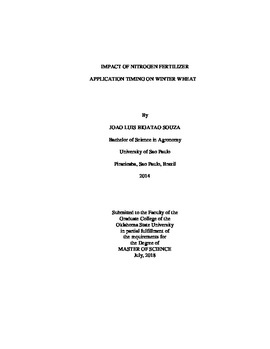| dc.contributor.advisor | Arnall, Daryl Brian | |
| dc.contributor.author | Bigatao Souza, Joao Luis | |
| dc.date.accessioned | 2019-03-25T20:05:26Z | |
| dc.date.available | 2019-03-25T20:05:26Z | |
| dc.date.issued | 2018-07-01 | |
| dc.identifier.uri | https://hdl.handle.net/11244/317705 | |
| dc.description.abstract | Trials were conducted over eight site-years during the 2016/17 and 2017/18 growing seasons in no-till dryland conditions in Oklahoma. A pre-plant treatment of 100 kg ha-1 of N was broadcast applied as ammonium nitrate (AN). When visual symptom differentiation (VSD) was documented between the pre-plant and the non-fertilized check, top-dress applications were performed every seven growing days (GDD>0) until 63 growing days after VSD at all sites. The objective of this study was to investigate the effect of delaying N applications based on in season VSD on winter wheat grain yield and protein. The results of the delayed applications were compared to the "standards" of pre-plant application and application made at first VSD. Considering all the data collected, the application of N and its timing had a significant effect on the yield and protein concentration of winter wheat. A negative effect on grain yield was observed when application was made later than late March. In addition, the optimum top dress timings considering all trials were between the agronomic range of 80 to 100 GDD>0 after planting. At this period, the data suggest no negative impact on yield but quite likely positive event as 100% yield recovery was achieved in relation to the pre-plant and 0 days after VSD between the pre-plant and 0DAVD. A best fit model indicated 100% yield recovery with N applications made to the point of 140 GDD>0 after planting. A significant finding of this work was that reaching maximum achievable yield levels was not related to the point in time at which the crop goes under N stress. Rather, optimum grain yield recovery was mostly associated with the N applications made when the crop was most vigorously growing, during the Feekes 6 and 7 growth stages. Evaluation of N timing on protein concentration showed a trend for increasing protein values with an increasing delay of application. Further studies should consider other environments, early planting dates, multiple N rates, and potential N sources to provide a better understanding of the influence of the N application timing on grain yield and protein. | |
| dc.format | application/pdf | |
| dc.language | en_US | |
| dc.rights | Copyright is held by the author who has granted the Oklahoma State University Library the non-exclusive right to share this material in its institutional repository. Contact Digital Library Services at lib-dls@okstate.edu or 405-744-9161 for the permission policy on the use, reproduction or distribution of this material. | |
| dc.title | Impact of Nitrogen Fertilizer Application Timing on Winter Wheat | |
| dc.contributor.committeeMember | Marburger, David A. | |
| dc.contributor.committeeMember | Lofton, Josh | |
| osu.filename | BigataoSouza_okstate_0664M_15927.pdf | |
| osu.accesstype | Open Access | |
| dc.description.department | Plant and Soil Sciences | |
| dc.type.genre | Thesis | |
| dc.type.material | text | |
